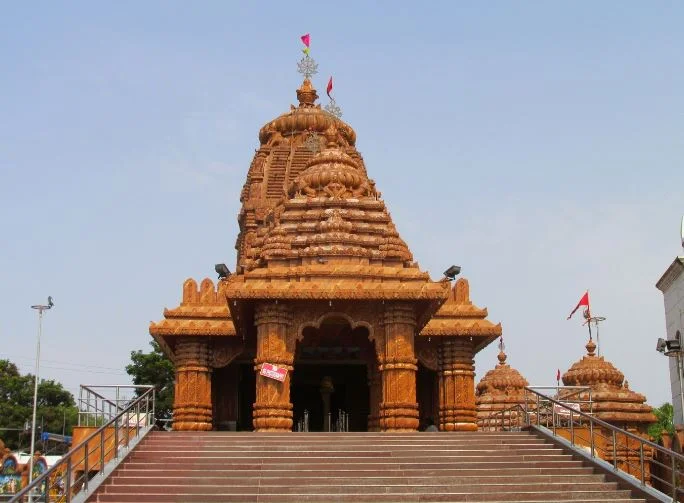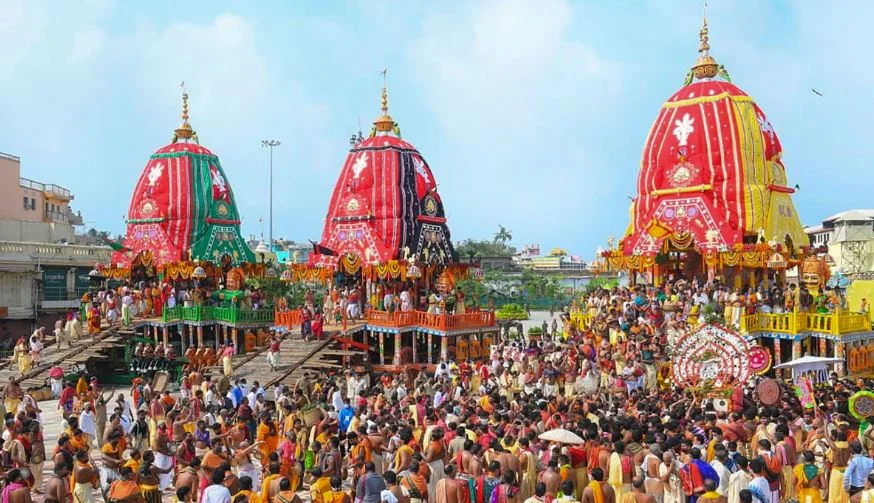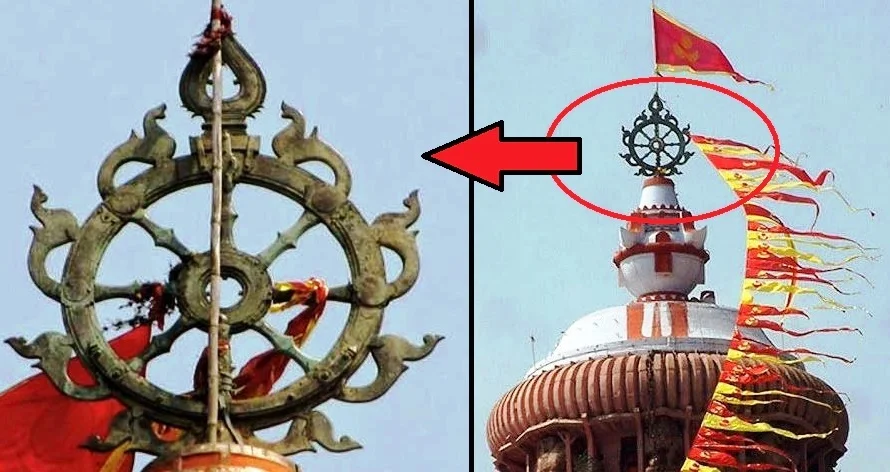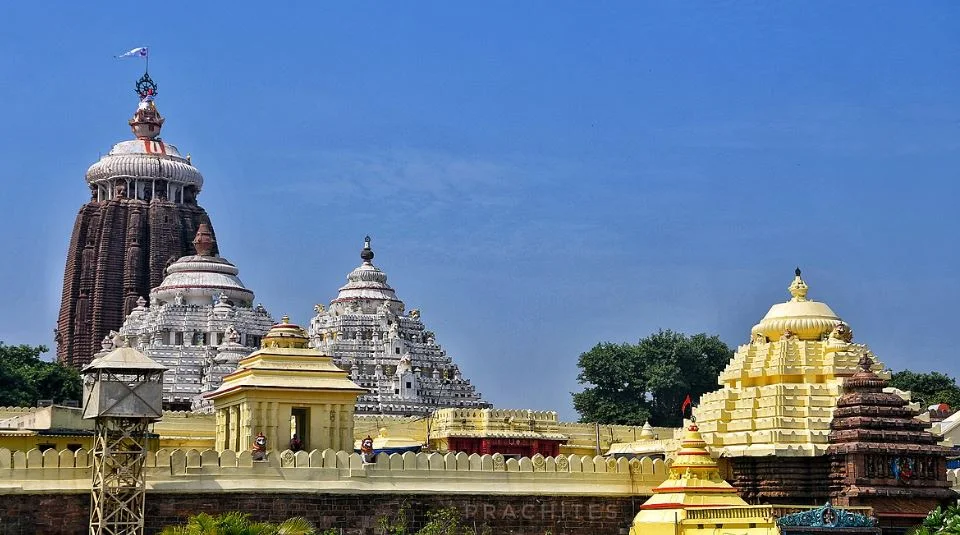Jagannath Temple of Puri, Odisha, is one of the Char Dham pilgrimage sites in India. Here are 16 facts about the Jagannath Temple.
The Jagannath Temple is a renowned Hindu temple dedicated to Lord Jagannath (a form of Lord Vishnu), located in Puri, Odisha, India.
Puri is well-connected by road, rail, and air, and the Jagannath Temple is situated in the heart of the town, making it easily accessible for visitors.
Facts About Jagannath Temple

Here are 16 interesting facts about Jagannath Temple.
1. Historical Facts About Jagannath Temple
The temple is believed to have been built in the 12th century and is famous for its striking architecture and religious significance. The main deities of the temple are Lord Jagannath, his sister Subhadra, and his elder brother Balabhadra. The idols are carved out of wood and are replaced every 12 or 19 years in a grand ritual known as the Nabakalebara.
- The Jagannath Temple is one of the most ancient and sacred Hindu temples located in Puri, Odisha, India.
- The temple is dedicated to Lord Jagannath, an incarnation of Lord Vishnu, and holds great historical and religious significance.
- It is believed to have been built in the 12th century by King Anantavarman Chodaganga Deva.
- The temple has witnessed centuries of devotion, pilgrimages, and cultural traditions, making it an important landmark in Hinduism.
- The Jagannath Temple is part of the Char Dham Yatra, a sacred pilgrimage circuit in India.
2. Unique Deities

The temple houses unique deities, Lord Jagannath, his sister Subhadra, and brother Balabhadra, collectively known as the “Trinity of Puri.”
- The deities are made of sacred Neem wood and are replaced with new idols in a grand ceremony called the Navakalevara once every 12 to 19 years.
- The idols are not sculpted but are carved in a specific shape known as the “Darubrahma” form.
- The Jagannath deity has a rounded shape, without any legs, symbolizing the formless aspect of divinity.
The deities are worshiped with great reverence and devotion, attracting millions of pilgrims and devotees every year.
3. Rath Yatra Facts About Jagannath Temple

The Jagannath Temple is famous for its annual Rath Yatra or Chariot Festival, which draws massive crowds from all over the world.
- During the Rath Yatra, the deities are placed on massive chariots and pulled through the streets of Puri.
- The chariots are beautifully decorated and have unique names: Nandighosa for Lord Jagannath, Taladhwaja for Lord Balabhadra, and Darpadalana for Devi Subhadra.
- The Rath Yatra is a symbol of Lord Jagannath’s journey to visit his aunt’s temple, Gundicha Temple, located a few kilometers away.
- The festival is celebrated with great enthusiasm and is considered an opportunity for devotees to have a direct darshan (sight) of the deities.
4. Mahaprasad Facts About Jagannath Temple
The Jagannath Temple is renowned for its Mahaprasad, a sacred food offering that is considered highly auspicious.
- The Mahaprasad is cooked in the temple’s kitchen, known as the “Rosaghar,” using traditional methods and strict rituals.
- The food is prepared without onion, garlic, or any other pungent spices and is considered pure and divine.
- The Mahaprasad consists of 56 different items, including rice, dal, vegetable curries, sweets, and cakes.
- It is believed that partaking in the Mahaprasad brings spiritual blessings and fulfillment of desires.
5. Nila Chakra and Flag

The Jagannath Temple is distinguished by its Nila Chakra (Blue Discus) placed on top of the main temple spire.
- The Nila Chakra is made of an alloy of eight metals and is adorned with various symbols and carvings.
- The Nila Chakra is considered highly sacred and represents Lord Vishnu’s Sudarshan Chakra.
- It is believed that the Nila Chakra protects the temple and its devotees from all evil and negative influences.
- The temple flag, known as the Patita Pavana Bana, flies high above the Nila Chakra and changes every day.
6. Anand Bazar
The Jagannath Temple features a unique tradition called the Anand Bazar, which translates to “Joy Market.”
- The Anand Bazar is a special market held inside the temple premises where devotees can buy and consume the Mahaprasad.
- It is considered a divine opportunity for devotees to directly taste and experience the blessed food offered to the deities.
- The Anand Bazar offers a range of Mahaprasad items, including sweets, dry snacks, and other delicacies.
- Devotees eagerly participate in the Anand Bazar to receive divine blessings and share in the joy of the temple.
7. Rituals and Daily Schedule
The Jagannath Temple follows a strict schedule of rituals and ceremonies throughout the day.
- The temple opens early in the morning and conducts various rituals like Mangala Arati, Mailam, Abakash, and Gopal Ballav.
- The deities are adorned with different outfits and jewelry according to specific rituals and occasions.
- Devotees can witness the rituals and seek the blessings of the deities during designated darshan timings.
- The daily schedule of the temple is meticulously maintained to ensure smooth functioning and the continuity of worship.
8. Prasad Distribution
The Jagannath Temple is dedicated to serving humanity through its Prasad distribution program.
- The temple provides free meals to thousands of devotees every day through its Annapurna Bhandar.
- The Annapurna Bhandar serves wholesome vegetarian meals, ensuring that no one leaves the temple hungry.
- The prasad distribution is carried out with utmost care and hygiene, maintaining the temple’s tradition of seva (service) and compassion.
- The initiative aims to alleviate hunger and nourish the body and soul of those visiting the temple.
9. Architecture and Temple Complex

The Jagannath Temple showcases exquisite Kalinga-style architecture, characterized by its pyramid-shaped spires and intricate carvings.
- The temple complex spreads over a vast area and consists of multiple structures, including the main temple, subsidiary temples, and various administrative buildings.
- The temple’s exterior walls are adorned with beautiful sculptures depicting scenes from Hindu mythology and legends.
- The temple’s sanctum sanctorum, known as the Garbhagriha, houses the deities and is considered the most sacred space in the temple.
- The overall architectural grandeur of the Jagannath Temple is a testament to the rich cultural heritage and artistic prowess of the region.
10. Brahma Paribartan Ritual
The Jagannath Temple is known for its unique ritual called the Brahma Paribartan, which translates to “Changing of the Soul.”
- This ritual involves transferring the life force or soul from the old idols to the new ones during the Navakalevara ceremony.
- The ritual is conducted in strict secrecy and is witnessed by only a select few priests and temple officials.
- It is believed that this intricate ritual ensures the continuity of divine presence and sanctity within the temple.
- The Brahma Paribartan ritual is carried out with utmost reverence, marking a significant event in the temple’s history.
11. Naba Kalebara Facts About Jagannath Temple
The Naba Kalebara Ceremony, also known as the Navakalevara, is a grand ceremony conducted at the Jagannath Temple.
- It is performed when the old wooden deities are replaced with new ones during specific astrological alignments.
- The ceremony involves the selection and carving of the sacred Neem wood from which the new idols are made.
- The Navakalevara ceremony attracts a massive influx of devotees and witnesses elaborate rituals and celebrations.
- It is considered an auspicious occasion, believed to bring prosperity and spiritual rejuvenation to the devotees.
12. Festivals and Celebrations
The Jagannath Temple is a hub of vibrant festivals and celebrations throughout the year.
- Besides the grand Rath Yatra, several other festivals like Chandan Yatra, Snana Yatra, and Kartik Purnima are celebrated with enthusiasm.
- Chandan Yatra involves applying sandalwood paste to the deities and is observed for a span of 21 days.
- Snana Yatra marks the ceremonial bathing of the deities on the full moon day of Jyeshtha month.
- Kartik Purnima witnesses the lighting of countless lamps and diyas within the temple complex, creating a mesmerizing spectacle.
13. Temple Administration and Ritual Hierarchy
The Jagannath Temple follows a well-defined administrative structure and ritual hierarchy.
- The temple administration is overseen by the Shree Jagannath Temple Administration (SJTA), responsible for the management and maintenance of the temple.
- A strict set of rules and regulations govern the functioning of the temple and the conduct of rituals.
- The temple rituals are carried out by a dedicated group of priests belonging to various designated families.
Each priestly family holds a specific responsibility and performs their respective rituals with precision and devotion.
14. Legend of Nilachakra
The Jagannath Temple’s Nila Chakra is steeped in mythology and legends.
- According to a popular legend, the Nila Chakra was brought from the mythical city of Dwaraka by Lord Krishna.
- It is believed that the Nila Chakra was offered to Lord Jagannath by Lord Krishna’s Queen Rukmini as a symbol of devotion.
- The Nila Chakra is considered a powerful symbol of protection and is worshipped with great reverence.
Devotees believe that a glimpse of the Nila Chakra brings blessings and fulfills their wishes.
15. Spiritual Significance
The Jagannath Temple holds immense spiritual significance for devotees, who consider it a sacred abode of Lord Jagannath.
- It is believed that a visit to the temple and seeking the darshan of the deities brings spiritual purification and blessings.
- The temple is regarded as a place of solace, where devotees can surrender their worries and seek divine guidance.
- The sacred atmosphere, the chants, and the rituals performed within the temple create a conducive environment for spiritual contemplation.
The spiritual significance of the Jagannath Temple attracts devotees from all walks of life, fostering a sense of unity and devotion.
16. Preservation of Traditions
The Jagannath Temple is dedicated to preserving and upholding the ancient traditions and cultural heritage associated with Lord Jagannath.
- The temple plays a pivotal role in promoting and safeguarding the unique rituals, practices, and customs followed for centuries.
- The temple administration and authorities work diligently to ensure the continuity of these traditions and their transmission to future generations.
- Efforts are made to educate visitors and devotees about the significance of the temple, its rituals, and the spiritual teachings embedded within them.
The preservation of traditions at the Jagannath Temple contributes to the overall cultural fabric of the region and enriches the spiritual lives of devotees.
How to Reach Jagannath Temple?
Jagannath Temple is situated on the eastern coast of India, it is located close to the Bay of Bengal. Puri, the town where the temple is located, is a major pilgrimage destination and attracts devotees from all over the world.
The annual Rath Yatra, or Chariot Festival, is a significant event associated with the Jagannath Temple. During this festival, the deities are placed on grand chariots and pulled by devotees through the streets of Puri.
Related Posts
- 21 Facts About Vaishno Devi
- 19 Facts About Amarnath
- 21 Facts About Kedarnath
- 27 Facts About Badrinath
- 16 Facts About Gangotri
- 17 Facts About Yamunotri